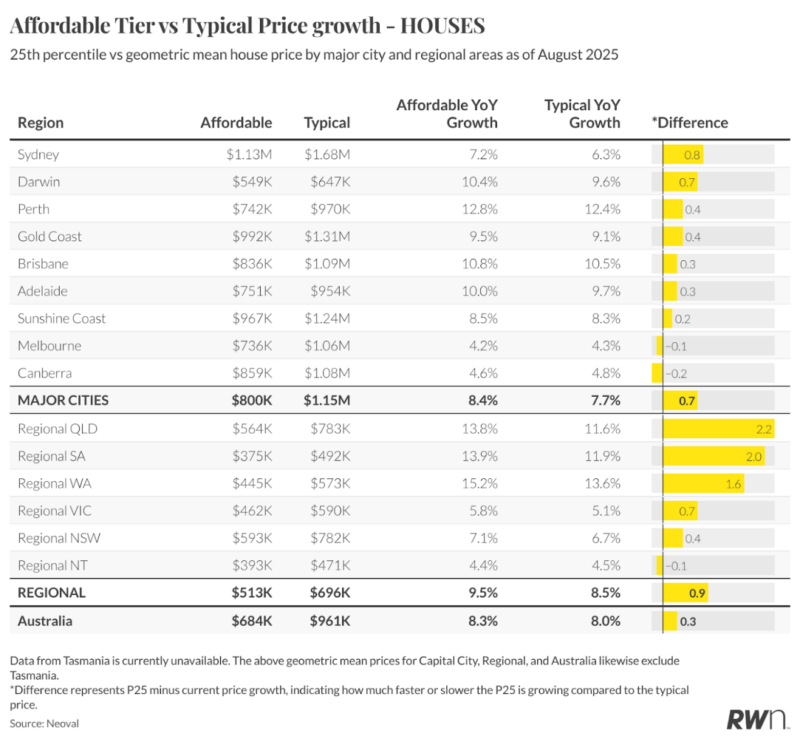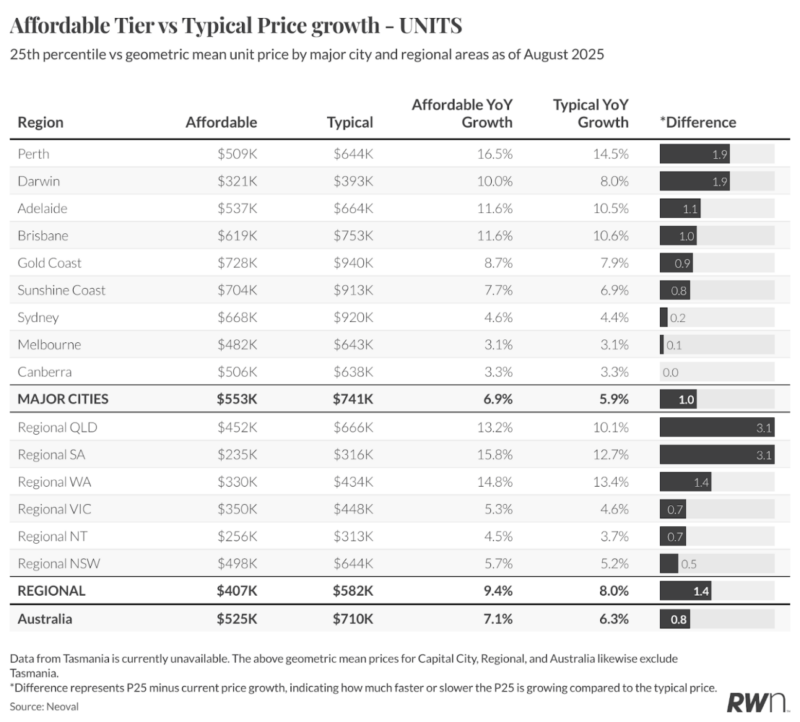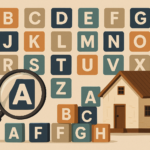
Key takeaways
Australia's most affordable housing is experiencing significantly stronger price growth than typical properties.
Affordable houses (bottom 25% of the market) are rising 8.3% annually vs 8.0% for typical homes.
Affordable units are up 7.1% annually, compared with 6.3% for the average unit.
The expanded First Home Buyer Guarantee scheme allows purchases with just a 5% deposit and no LMI.
Incentives reduce upfront costs but also drive up demand and prices, making it harder to secure affordable homes.
The affordable end of the market offers strong growth potential, especially in the regions.
Australia’s property market is full of contradictions.
While affordability remains one of the biggest challenges facing buyers, the so-called “affordable end” of the market is actually outperforming.
Australia's most affordable housing is experiencing significantly stronger price growth than typical properties, according to Nerida Conisbee, Chief Economist at Ray White.
The trend is consistent across most states and regions, creating a structural shift in how different price brackets perform.
Moving forward this segment will be fuelled by first home buyers who will been turbocharged by government incentives.
Affordable properties outperforming the broader market
According to the latest figures from Ray White, affordable houses, defined as properties priced in the bottom quartile, are growing at 8.3% annually, compared to 8.0% for typical homes.

Source: Ray White
For units, the difference is even greater, with affordable apartments surging 7.1% a year against 6.3% for the broader market.
This might sound modest, but the impact is magnified when you break it down city by city and region by region:
-
Sydney: Affordable houses at $1.13 million are rising 7.2% annually, compared to 6.3% for typical houses. That’s almost a full percentage point faster in what is already Australia’s most expensive market.
-
Regional Queensland: Affordable houses are surging 13.8% annually, a full 2.2 percentage points higher than the rest of the market.
-
Regional South Australia: Affordable houses are rising 2.0 percentage points faster than typical homes.
-
Regional Western Australia: Affordable houses are 1.6 points ahead of the broader market.
And the affordable unit market tells a similar story.

Source: Ray White
Perth’s entry-level apartments are leading the nation, up a massive 16.5% annually, compared with 14.5% for typical units.
Regional Queensland and South Australia’s affordable units also show premiums of more than 3 percentage points.
Government incentives: the key demand driver
So what’s behind this surge? In short: government policy.
The expansion of the First Home Buyer Guarantee scheme has rewritten the rules of entry-level housing.
By removing income caps and increasing price thresholds , up to $1.5 million in Sydney, $950,000 in Melbourne, and $1 million in Brisbane , the scheme has widened the pool of eligible buyers dramatically.
From October 1st buyers can enter the market with just a 5% deposit and avoid paying lenders mortgage insurance (LMI). For many households, that’s a saving of $20,000 to $40,000 upfront.
Treasury estimates suggest the expanded scheme will issue 20,000 additional guarantees in its first year alone.
That’s a huge injection of demand into the exact part of the market that’s already the tightest.
Nerida Conisbee, Chief Economist at Ray White, summed it up well when she said:
“First home buyer incentives are fueling the affordable housing boom as cheaper properties outpace market averages.”
And it’s not just federal policy.
State governments are layering on stamp duty exemptions, grants, and shared equity schemes, all of which direct buyers to the same affordable tier.
That means the bottom of the market is effectively being propped up by multiple levels of government at once.
Why Melbourne and Canberra are the exceptions
Interestingly, not every city is seeing the same dynamic.
Melbourne and Canberra are bucking the trend, with affordable properties underperforming slightly.
-
In Melbourne, affordable houses are growing at 4.2%, compared with 4.3% for typical homes — the only major city where affordable stock is actually lagging.
-
In Canberra, affordable homes trail by 0.2 percentage points, and for units, both cities show no premium at all.
The reason? Supply.
Ms Conisbee explains:
"Melbourne has long been able to bring new housing stock online quickly, thanks to its extensive land releases, planning frameworks, and an established development industry geared toward medium-density housing.
Canberra benefits from its compact urban form and a proactive government land release program, ensuring new supply can be delivered at multiple price points."
This highlights a critical truth: demand-side incentives only drive prices higher if supply can’t keep up. Where supply is responsive, the “affordable premium” doesn’t appear.
A shrinking pool of affordable homes
Nationally, the pool of genuinely affordable properties is shrinking fast according to Conisbee.
With median house prices now approaching $1 million nationally, fewer homes are priced below $800,000.
That funnels competition into a narrowing segment, intensifying price growth at the lower end.
According to Ms Conisbee, this is particularly evident in regional markets, where stock is thin to begin with.
Regional Queensland and South Australia stand out as examples where the combination of limited supply and heightened demand is driving affordable properties well ahead of the market average.
What it means for buyers
For first home buyers, the landscape is mixed.
On one hand, incentives make it easier to get in, lower deposits, no LMI, and higher thresholds.
On the other hand, these very policies are driving up prices in the exact segment they target.
It’s a classic policy dilemma: incentives reduce barriers, but by stoking demand, they also erode affordability.
What it means for investors
Properties at the lower end of the market are benefiting from strong demand, policy support, and limited supply: all ingredients for capital growth.
Investors who can identify well-located affordable stock in areas with population growth and strong infrastructure pipelines may find themselves in the sweet spot.
But investors also need to be careful. Blindly chasing “affordable” stock without understanding the local dynamics could backfire.
Looking ahead
The big picture is that Australia’s property market is being reshaped at the bottom end.
First home buyer schemes, demographic shifts (with millennials now in peak buying years), and persistent supply shortages are creating structural outperformance in affordable housing.
For buyers, it means affordability pressures aren’t easing; they’re just shifting.
For investors, it highlights a key trend worth following closely.
And for policymakers, it raises an uncomfortable question: are we really making housing more affordable, or just pushing up prices in the one segment meant to be the most accessible?














